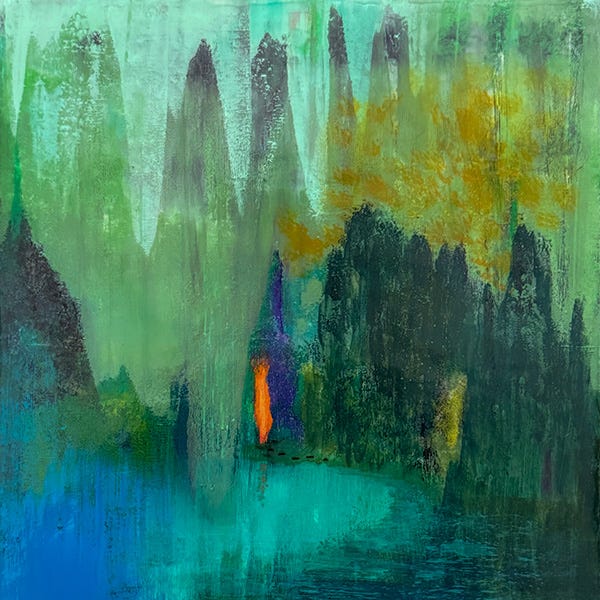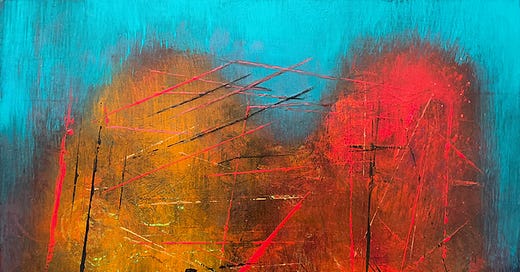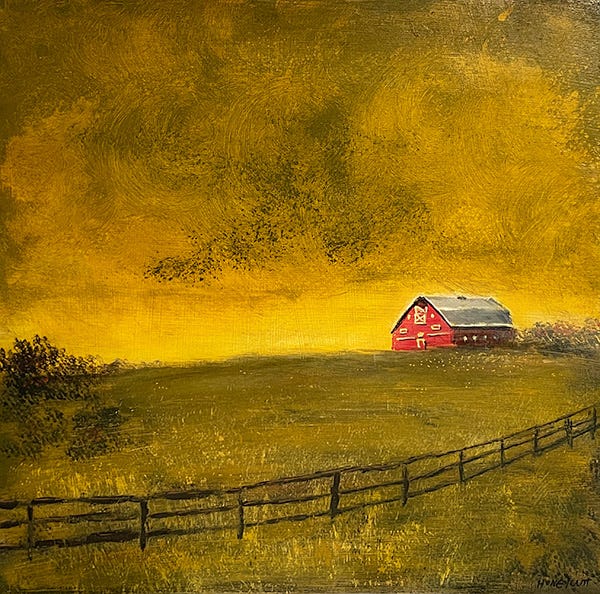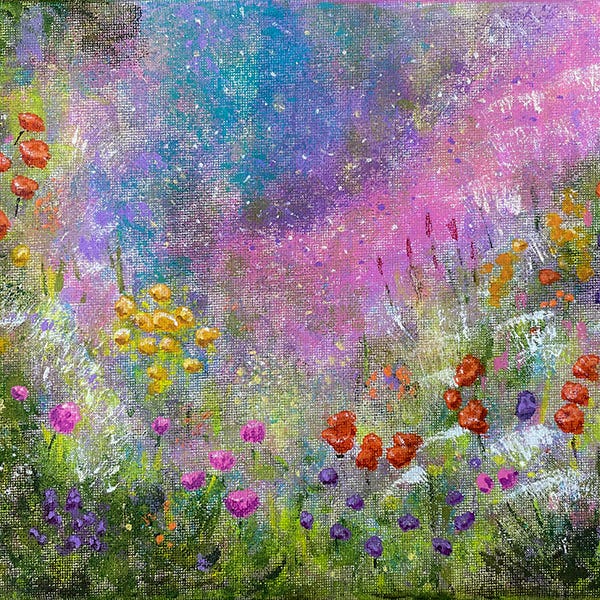The Secret Garden of Creativity
Reclaiming a slower, truer way of making amidst grief and self-erasure.
This piece is the first in a series of quiet collaborations with my brother, Jim Honeycutt. His paintings—like the conversations we keep having—emerge from the soil of grief, presence, and creative longing. I’m honored to weave his visual art into this reflection on authenticity, self-erasure, and the secret garden of creativity. You can explore more of Jim’s work at James Honeycutt Art.
A Quiet Conversation
It was Saturday evening. My body was tired, my heart full. That morning I’d been writing vulnerably about my father, sorting through grief and the difficult work of setting new boundaries. Later, Bonnie and I attended a political protest. “This is what democracy looks like,” we chanted in the sunlight. There was pride, but also grief—for what had been lost, and for the painful ways we and others remain unseen.
That day moved like a river through memory and momentum, heartbreak for unseen contributions in both personal and political spheres, and the persistent hope for a more just and visible world. So when Jim reached out, I wasn’t sure I had the energy to respond. But I’m glad I did. Exhaustion, it turns out, can sometimes open the heart rather than close it.
By that evening, we were on the phone together, connecting and supporting each other.
Our conversation felt like a green shoot breaking through dark, wet soil. Grief was close to the surface: the loss of our mom, of his beloved dog Jaeger, of shared political hope. But so was something else—something quieter. The stirrings of creative longing. A question about how to be in right relationship with our work, our worth, and ourselves.
The Invisible Wound
Jim shared a story from work. Years ago, he’d built an expansive library of UX design—hundreds of interlocking pieces, lovingly curated. Then, in a leadership shift at his company, everything he created was quietly shelved. No recognition. No closure. Just disappearance.
Reflecting on the shelving and his lingering stuck-ness — “That’s egoic,” he told me. “I should be grateful. I have a great income. I have time for my painting. I should be happy.”
And: “I’m just a malcontent.”
And then this: “I wish I could erase this part of myself.”
That landed like a punch.
What gets lost in these moments isn’t just product—it’s selfhood. When your work is dismissed, it’s easy to dismiss the parts of you that made it. The voice. The vision. The care. And when no one else validates that hurt, we often begin erasing ourselves.
I recognized that move.
Gaslit, Then Self-Gaslighting
“They silenced you,” I said. “And now you’re silencing yourself.”
Jim’s experience was not textbook gaslighting. No one told him he was crazy. But the effect was similar: a denial of reality so subtle, so complete, that he began to deny it to himself. This is the quieter form—the internalized kind. The self-eviction from one's own truth.
And I knew it well.
In my own experience of seeking trauma therapy in later life, I remember whispering to myself: “You’re a coach. You shouldn’t have trauma.” As if professionalism made me immune. As if pain disqualified me from serving others. That belief—subtle, sanctioned by culture—was its own form of gaslighting.
It wasn’t until I began to repeat a new mantra that things shifted:
“Your experience is valid.”
Even if it’s messy. Even if it’s inconvenient. Even if it’s human.
This truth—this mantra—became a ground I could finally stand on. Without it, there is no center. No soil. No seedbed for anything real.
I offered Jim the same idea. We named the grief. The grief of being unseen. The grief of losing Jaeger. The grief of democracy fraying. The grief of losing our mom. And then I offered him a word I made up:
A nostalgia for what never was, but might have been. The yearning for recognition that never arrived. The soft ache of unlived moments—and the beauty of letting that ache be poetry instead of pathology.
Creativity Is Not a Factory
Our conversation drifted toward art. Jim paints—boldly, colorfully, with a style that balances discipline and wildness. But lately, something had been off.
He told me about his weekly Instagram painting group. Each Friday, he posts a new piece. It started as a joyful practice. But over time, the ritual began to feel like a deadline. “It keeps me going,” he said. “But it also pressures me to be presentable.”
I remarked that his frenetic pace sounded like burning sugar for energy - quick excitation followed by the inevitable crash. He laughed in recognition.
I heard it clearly: the Taskmaster had entered the studio.
Jim’s Taskmaster, like mine, is relentless. It believes in achievement. In output. In proving your worth through what you produce. It doesn’t ask how you’re feeling or if you’re grieving. It asks, “What do you have to show for it?”
This inner figure doesn’t arise from nowhere. It’s born in the systems we swim in: school, performance reviews, social media metrics, economic scarcity. We internalize these industrial values so early that we mistake them for virtue. We forget that creativity is not a job title—it’s a birthright.
So we try to manage creativity. We measure it. Quantify it. Schedule it.
But the deeper truth is this: Creativity isn’t something we perform. It’s something we return to. It's already who we are. The moment we try to control it, we lose touch with it.
Sometimes, I think we don’t create from our essence because we’re afraid it won’t be enough. We’d rather perform something polished than risk revealing something true. We seek external validation when what we really long for is inner congruence.
So I told him, quietly but clearly:
Productivity is not creativity.
Productivity is a factory. Creativity is a garden.
And something shifted.
After our call, Jim went to his easel. No plan. No deadline. Just paint. What emerged was some of his most honest, unguarded work yet. Not because he forced it—but because he stopped trying to force anything at all.
Cultivating the Secret Garden
The secret garden isn’t secret because it’s hidden. It’s secret because most of us forget it exists. Or we remember only in glimpses—early morning dreams, dusk-colored walks, the sudden urge to write or weep or create.
It’s sacred because it’s ungoverned. Because it belongs to no one else. Because it cannot be forced.
Gardens don’t respond to productivity software. They don’t bloom because you planned for them to. They bloom because you made space for them to grow.
To tend a creative life is not to control it. It’s to cultivate it.
To cultivate means to prepare the soil. To water what’s emerging. To clear away what no longer serves. Not with judgment, but with care. The slow, sacred labor of kneeling beside your own becoming.
When Jim paints from this place, it’s different. He doesn’t rush. He lets the brush find its own rhythm. The canvas becomes a companion, not a performance.
When I write from that same place, I feel my breathing slow. I feel time dilate. The words arrive not in neat rows, but in soft waves. And I trust them—even the tangled ones.
David Whyte writes that “the antidote to exhaustion is not rest, it’s wholeheartedness.”
And gardens are nothing if not wholehearted. They don’t compartmentalize. They don’t hold back. Every leaf opens toward the light.
In the garden, we learn to weed—but gently. To pull out what strangles, not because it’s bad, but because it has overgrown its purpose. In me, weeding looks like noticing when I’m pushing for approval instead of writing from alignment. It looks like asking: Am I present? Or am I performing?
There is joy in watering something you didn’t plan. In watching a color appear you didn’t mix. In tending grief and discovering beauty growing through the cracks.
Gardens surprise us.
They don’t always grow what we expected. But they grow what’s needed.
Where is this garden?
It lives in the quiet epicenter of the heart—between self and soul, where doing softens into being. In that liminal terrain of becoming, beyond roles and recognition, where we are neither striving nor hiding, but simply alive.
You don’t build the secret garden.
You don’t earn it.
You remember it.
And if you listen, it remembers you, too.

Flow First
In the Bhagavad Gita, there’s a line I return to often:
“Do you have the patience to wait until the mud settles and the water is clear?”
“Do you have the courage to remain unmoving until the right action arises by itself?”
The Taskmaster wants to schedule inspiration. The culture demands content. But the soul isn’t a machine. It does not respond to deadlines.
What if you let go of effort, just for a moment?
What if your next work of art—your next truth—didn’t come from hustle, but from stillness?
That’s what I’m practicing now. And that’s what Jim, in his own way, is beginning to live.
The First Bloom
What’s blooming now, days later, isn’t a resolution. It’s a remembering.
That when you stop silencing yourself, when you treat your ache as soil, something begins to grow. Slowly. Softly. Unscheduled.
It might look like grief. Or gentleness. Or just enough breath to feel yourself again.
But that is the beginning.
If you take one thing from this post, let it be this:
Slowing down is not laziness. Turning inward is not weakness. It is the call of your soul.
The garden is there.
Tend it.
And wait.
Something beautiful is already reaching for the light.
Jim, thank you—for your art, your honesty, and for letting me share a piece of your creative journey here. The secret garden blooms brighter with you in it.
More of Jim’s work can be seen at James Honeycutt Art.







John, thank you for your advice the other day, you've helped me find my way back to my path, and the art is flowing once again!
This is all so beautifully said, thank you for this and for the stand that you take for all of us. You make a difference in my life, daily now.
In my art practice, I like to frame this concept as left brain vs right brain.
My left brain can't paint. My left brain is overdeveloped, as a consequence of a lifetime that you described, 35 years in a corporate career that rewards results over all. Left brain is still needed, it helps keep me organized and keeps the bills paid and the lights burning.
But right brain is where all the REALLY good stuff lives. That's where I can create from.
I see my left brain as: task-oriented; performance-based; fast; masculine energy; time-bound; anxious; pushing; striving; grasping; pushing away; closed; ego.
I see right brain as: creative; timeless; slow; gentle; feminine energy; accepting; calm; open; universal.
My right brain is where I trade the cramped, grasping energy of ego for the spaciousness of ego dissolution and flow. When I'm fully in right brain, there is no ego, no anxiety, no grasping or avoiding, just the pure BLISS of creating, without thought, without ego.
The words in our conversation the other day that landed the most for me include:
Downshift: oh boy, my (left brain) Taskmaster part does NOT like that word. He's been trying to control my art practice, and that just doesn't work. He wants to go faster, not slower. Under his guidance, my art becomes lifeless and stops flowing.
Garden (vs assembly line): I really FEEL that word. That's probably the best word to describe the feeling of my art studio, when I'm in flow. I want to make a sign in my studio that visually illustrates garden > assembly line.
I love this one, John. Your description of the garden of creativity brings to my mind a conversation either dear friends I had a couple years ago where we arrived at a new definition of Spirituality. “The art of cultivating a more direct experience of reality.”
Productivity doesn’t do a damn thing. One has to make space, notice, allow experience to arise, remove what no longer serves, take time, be patient and curious.